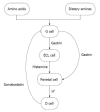Importance of gastrin in the pathogenesis and treatment of gastric tumors
- PMID: 19115463
- PMCID: PMC2653300
- DOI: 10.3748/wjg.15.1
Importance of gastrin in the pathogenesis and treatment of gastric tumors
Abstract
In addition to regulating acid secretion, the gastric antral hormone gastrin regulates several important cellular processes in the gastric epithelium including proliferation, apoptosis, migration, invasion, tissue remodelling and angiogenesis. Elevated serum concentrations of this hormone are caused by many conditions, particularly hypochlorhydria (as a result of autoimmune or Helicobacter pylori (H pylori)-induced chronic atrophic gastritis or acid suppressing drugs) and gastrin producing tumors (gastrinomas). There is now accumulating evidence that altered local and plasma concentrations of gastrin may play a role during the development of various gastric tumors. In the absence of H pylori infection, marked hypergastrinemia frequently results in the development of gastric enterochromaffin cell-like neuroendocrine tumors and surgery to remove the cause of hypergastrinemia may lead to tumor resolution in this condition. In animal models such as transgenic INS-GAS mice, hypergastrinemia has also been shown to act as a cofactor with Helicobacter infection during gastric adenocarcinoma development. However, it is currently unclear as to what extent gastrin also modulates human gastric adenocarcinoma development. Therapeutic approaches targeting hypergastrinemia, such as immunization with G17DT, have been evaluated for the treatment of gastric adenocarcinoma, with some promising results. Although the mild hypergastrinemia associated with proton pump inhibitor drug use has been shown to cause ECL-cell hyperplasia and to increase H pylori-induced gastric atrophy, there is currently no convincing evidence that this class of agents contributes towards the development of gastric neuroendocrine tumors or gastric adenocarcinomas in human subjects.
Figures





References
Publication types
MeSH terms
Substances
Grants and funding
LinkOut - more resources
Full Text Sources
Other Literature Sources
Medical

